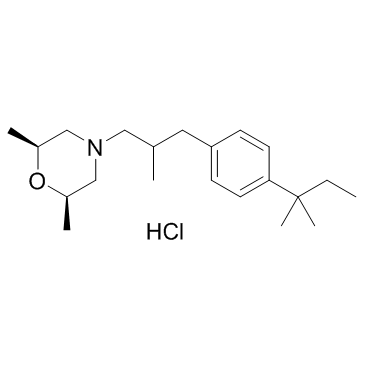Amorolfine hydrochloride

Amorolfine hydrochloride structure
|
Common Name | Amorolfine hydrochloride | ||
|---|---|---|---|---|
| CAS Number | 78613-38-4 | Molecular Weight | 353.970 | |
| Density | 1.234 | Boiling Point | 78-82°C (9 Torr) | |
| Molecular Formula | C21H36ClNO | Melting Point | N/A | |
| MSDS | Chinese USA | Flash Point | N/A | |
| Symbol |


GHS07, GHS09 |
Signal Word | Warning | |
Use of Amorolfine hydrochlorideAmorolfine hydrochloride is a antifungal reagent.Target: AntifungalAmorolfine is an antifungal showing activity against fungi pathogenic to plants, animals and humans. Amorolfine possesses a broad antifungal spectrum including dermatophytes, yeasts, dimorphic fungi and moulds and is not only fungistatic but fungicidal against most species [1]. At 0.2, 2 and 5 micrograms/ml amorolfine did not have any significant inhibitory or enhancing effect on phagocytosis whether following simultaneous addition of blastospores and drug to the neutrophils, prior treatment of neutrophils for 2 h before addition of blastospores or prior treatment of blastospores for 2 h. Simultaneous addition of amorolfine resulted in a significant increase in killing at all concentrations. This increase was not significantly enhanced by either preincubation of neutrophils or blastospores for 2 h with the drug [2]. |
| Name | amorolfine hydrochloride |
|---|---|
| Synonym | More Synonyms |
| Description | Amorolfine hydrochloride is a antifungal reagent.Target: AntifungalAmorolfine is an antifungal showing activity against fungi pathogenic to plants, animals and humans. Amorolfine possesses a broad antifungal spectrum including dermatophytes, yeasts, dimorphic fungi and moulds and is not only fungistatic but fungicidal against most species [1]. At 0.2, 2 and 5 micrograms/ml amorolfine did not have any significant inhibitory or enhancing effect on phagocytosis whether following simultaneous addition of blastospores and drug to the neutrophils, prior treatment of neutrophils for 2 h before addition of blastospores or prior treatment of blastospores for 2 h. Simultaneous addition of amorolfine resulted in a significant increase in killing at all concentrations. This increase was not significantly enhanced by either preincubation of neutrophils or blastospores for 2 h with the drug [2]. |
|---|---|
| Related Catalog | |
| References |
| Density | 1.234 |
|---|---|
| Boiling Point | 78-82°C (9 Torr) |
| Molecular Formula | C21H36ClNO |
| Molecular Weight | 353.970 |
| Exact Mass | 353.248535 |
| PSA | 12.47000 |
| LogP | 5.40190 |
| InChIKey | XZKWIPVTHGWDCF-KUZYQSSXSA-N |
| SMILES | CCC(C)(C)c1ccc(CC(C)CN2CC(C)OC(C)C2)cc1.Cl |
| Storage condition | room temp |
| Symbol |


GHS07, GHS09 |
|---|---|
| Signal Word | Warning |
| Hazard Statements | H302-H315-H411 |
| Precautionary Statements | P301 + P312 + P330 |
| Hazard Codes | Xn |
| Risk Phrases | R20/21/22 |
| Safety Phrases | 26-36 |
| RIDADR | UN 3077 9 / PGIII |
| HS Code | 29411010 |
| HS Code | 29411010 |
|---|
|
The low keratin affinity of efinaconazole contributes to its nail penetration and fungicidal activity in topical onychomycosis treatment.
Antimicrob. Agents Chemother. 58(7) , 3837-42, (2014) Onychomycosis is a common fungal nail disease that is difficult to treat topically due to the deep location of the infection under the densely keratinized nail plate. Keratin affinity of topical drugs... |
|
|
Characterization of Antifungal Activity and Nail Penetration of ME1111, a New Antifungal Agent for Topical Treatment of Onychomycosis.
Antimicrob. Agents Chemother. 60 , 1035-9, (2016) Fungal nail infection (onychomycosis) is a prevalent disease in many areas of the world, with a high incidence approaching 23%. Available antifungals to treat the disease suffer from a number of disad... |
|
|
Mechanism of Action of ME1111, a Novel Antifungal Agent for Topical Treatment of Onychomycosis.
Antimicrob. Agents Chemother. 60 , 873-80, (2016) Despite the existing treatment options for onychomycosis, there remains a strong demand for potent topical medications. ME1111 is a novel antifungal agent that is active against dermatophytes, has an ... |
| (2R,6S)-2,6-Dimethyl-4-{2-methyl-3-[4-(2-methylbutan-2-yl)phenyl]propyl}morpholine hydrochloride (1:1) |
| Loceryl |
| Locetar |
| Amorolfine Hydrochloride |
| (2R,6S)-2,6-Dimethyl-4-{2-methyl-3-[4-(2-methyl-2-butanyl)phenyl]propyl}morpholine hydrochloride (1:1) |
| MFCD00903738 |
| Curanail |
| Amorolfine HCl |
| Odenil |
| Morpholine, 4-[3-[4-(1,1-dimethylpropyl)phenyl]-2-methylpropyl]-2,6-dimethyl-, (2R,6S)-, hydrochloride (1:1) |